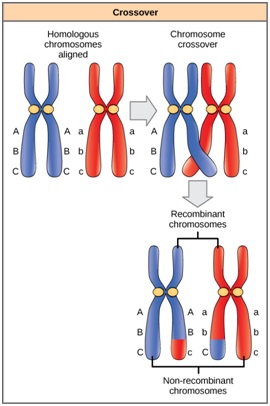Linkage vs Recombination
Between Linkage and Recombination we can identify certain differences as they are two different concepts related to genetics. Therefore, they shouldn’t be confused. In fact, linkage describes the occurrence of genes on the same chromosome and recombination describes the mixing up of genes between homologous chromosomes during meiosis via the process called crossing over.
What is Linkage?
Genes that are located close together in the same chromosome is known as linked genes. Since they are close to each other and situated in the same chromosome, they are called linked group and tend to inherit together as a unit during meiosis of cell division. That is linked genes do not obey Mendel’s principle of independent assortment (two alleles located at a certain locus/ location separate (segregate) into two cells independently from other alleles at other loci).
Linkage can be separated into two types:
Complete linkage – when genes are located very close together and do not show crossing over, it is known as complete linkage. This result in non-recombinant progeny. That is phenotype and genotype of progeny plants are as the same as their mother plants.
Incomplete linkage – when genes are located in same chromosome and show some crossing over during meiosis are said to be incompletely linked genes. Testing for incomplete linkage can be done using a testcross. For example, a plant that is heterozygous for two characters should be crossed with a plant that is recessive for that particular character. This type of cross produces two recombinant gametes and two non-recombinant gametes. E.g. pattern baldness in men linked to genetic markers in X chromosome and the color of the thorax and that of the puparium of Australian blowfly Luciliácuprina.

Baldness example for Incomplete linkage
According to how alleles of linked genes are located on homologous chromosomes, there are two types of configurations as follows:
Coupling (Cis) configuration – situation where two dominant alleles are on one chromosome and two recessive alleles are on the other chromosome.
Repulsion (Trans) configuration – situation where each chromosome contains one dominant and a recessive allele.
What is Recombination?
Genes that are located in the same chromosome can shift from one homologous chromosome to the other via the process called crossing over. It results in chromosomes with new gene combinations compared to their mother cell gene arrangement (fig. 2). Therefore, chromosomes with this new gene combinations are known as recombinant chromosomes and thus the process is called recombination.

Crossover produce recombinants
The percentage of recombinants produced in a cross is called recombination frequency, this can be calculated as follows:
Recombination frequency = (Number of recombinant in the progeny) / (Total number in the progeny) 100 %
There are two types of recombination processes that can take place during meiosis:
Interchromosomal recombination – recombination takes place between genes situated on different chromosomes. E.g. independent assortment of anaphase of meiosis I.
Intrachromosomal recombination – recombination takes place between genes located on the same chromosome. E.g. crossing over of prophase of meiosis I.
When recombination occurs in linked genes, resulting progeny exhibits a majority of non-recombinants and less frequency of recombinants.
What is the difference between Linkage and Recombination?
• Linkage helps to keep certain genes together in the same chromosome whereas, process of recombination mix genes between chromosomes.
• Linkage is a phenomenon that can be seen in any type of cell. However, recombination is a process that occurs during meiosis I.
• Recombination does not occur when there is complete linkage. However, recombination occurs when genes are not completely linked (or when they are incompletely linked).
• Incompletely linked genes undergo intrachromosomal recombination.
• When recombination occurs in independently assorting genes, recombinants and non-recombinants occur in equal proportions whereas, when recombination occurs in incompletely linked genes recombinant frequency is less than 50% and non-recombinant frequency is more than 50%.
• Both linkage and recombination can be used to build genetic maps/ linkage analysis (maps that show gene locations).
Images Courtesy:.
ncG1vNJzZmivp6x7pbXFn5yrnZ6YsqOx07CcnqZemLyue8OinZ%2Bdopq7pLGMm5ytr5Wau264yKeimp%2BVYq6vsIyvqmaqlZi8rq7Ip5itoZ%2BjfA%3D%3D